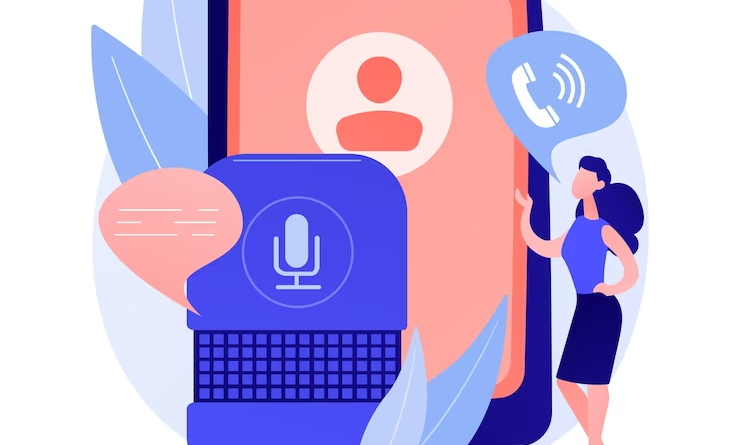How a VOIP Call Recording App Can Improve Your Customer Service Strategy
Introduction
In today’s fast-paced business world, customer service is one of the most important aspects of any successful company. Consumers want to feel valued and heard, and their satisfaction can make or break a business. To meet these expectations, companies must invest in effective communication tools to build strong relationships with customers.
One of the most powerful tools available to businesses today is a VOIP call recording application. These apps can significantly improve your customer service strategy and help you achieve your business goals. In this article, we’ll explore the benefits of using a VOIP call recording app, how it can improve your customer service strategy, and why it’s a valuable investment for your business.
Benefits of using a VOIP call recording app for a customer service strategy
1. Monitor call quality
One of the significant benefits of using a VOIP call recording application is the ability to monitor the quality of customer service calls. By recording calls, businesses can evaluate the tone, language and level of professionalism displayed by customer service representatives. Call quality tracking helps businesses identify areas where customer service representatives can improve and provide feedback to them.
2. Analyze call data
VOIP call recording application records all call data including call duration, waiting time and the number of customer service contacts. Analyzing this data helps businesses identify patterns and trends in customer service interactions. This analysis can provide insight into areas where customer service processes can be improved and streamlined to improve the customer experience.
3. Train and develop employees
A VOIP call recording application can be used as a tool for employee training and development. By reviewing recorded calls, businesses can identify areas where employees need improvement and provide them with targeted training. In addition, call recordings can be used to demonstrate exemplary customer service interactions with employees, giving them real-world examples of how to handle various customer service scenarios.
4. Compliance and Legal Requirements
In some industries, businesses are required to record customer service calls for legal and compliance purposes. A VOIP call recording application can help businesses meet these requirements while providing the benefits listed above.
5. Improve the customer experience
By using a VOIP call recording application to improve call quality and analyze data, businesses can improve the customer experience. With better-trained employees and more efficient customer service processes, customers are more likely to have positive experiences when interacting with a business. This in turn can lead to increased customer satisfaction and loyalty.
Understanding the Basics of VOIP Call Recording
In today’s digital age, businesses have moved to a cloud-based phone system to make and receive calls. With this shift, VOIP call recording has become an essential part of a customer service strategy. In this chapter, we will discuss the basics of VOIP call recording, its features, types and benefits.
Definition of VOIP call recording and its functionality
VOIP Call Recorder is a software application that allows users to record voice calls in the cloud. It is an effective and cost-effective solution for businesses that want to improve the quality of their customer service. The primary function of VOIP call recording is to capture and store all voice calls made and received by a business.
Some of the basic VOIP call recording features include:
- Call monitoring: Allows managers to listen to a live call or view recorded calls and evaluate the performance of their agents.
- Compliance: VOIP call recording helps businesses meet legal call recording requirements.
- Quality Assurance: Enables businesses to assess the quality of their customer service.
An overview of the different types of VOIP call recording
There are primarily two types of VOIP call recording: active and passive.
- Active Call Recording: With this type, call recording starts automatically when the call connects. Requires user permission to record calls.
- Passive call recording: In this type, the user has to start the call recording manually.
The benefits of VOIP call recording for a customer service strategy
VOIP call recording provides businesses with several benefits that can help improve their customer service strategy. Some of the significant benefits include:
- Training and Coaching: VOIP call recording allows managers to train and coach their agents to improve their performance.
- Dispute resolution: VOIP call recording provides businesses with a detailed record of the call that can help resolve any disputes that may arise.
- Compliance: VOIP call recording helps businesses meet regulatory requirements for call recording.
- Performance Evaluation: VOIP call recording allows managers to evaluate the performance of their agents and identify areas that need improvement.
In conclusion, VOIP call recording is an essential tool for businesses looking to improve their customer service strategy. It provides businesses with a cost-effective and efficient solution to meet their call recording needs. With the right VOIP call recording application, businesses can improve the quality of their customer service, improve compliance and increase customer satisfaction.
Choosing the Right VOIP Call Recording Application
When choosing a VOIP call recording application, businesses need to consider several factors to ensure they choose the right solution for their needs. In this chapter, we’ll discuss the factors to consider when choosing a VOIP call recording app, compare the different apps available in the market, and recommend features to look for in a VOIP call recording app.
Factors to consider when choosing a VOIP call recording application
- Compatibility: A VOIP call recording application should be compatible with the company’s phone system.
- Storage capacity: The application should have enough storage capacity to store all recorded calls.
- Ease of use: The application should be user-friendly and easy to operate.
- Price: The application should be cost-effective and provide value for money.
Comparison of different VOIP call recording apps available in the market
There are several VOIP call recording apps available in the market. The most popular ones include:
- Moon Dialer
- CallRail
- Talkdesk
- Five9
- Aircall
Recommended features to look for in a VOIP call recording app
- Cloud-Based: The application should be cloud-based to allow easy access to recorded calls.
- Integration: The application should integrate with other business applications such as CRM and analytics tools.
- Security: The app should have robust security measures to protect recorded calls.
- Customization: The app should allow you to customize the recording settings to suit the specific needs of your business.
In conclusion, choosing the right VOIP call recording application can have a significant impact on a company’s customer service strategy. After considering factors such as compatibility, storage capacity, ease of use, and pricing, businesses can make an informed decision when choosing an app. Additionally, businesses should look for features such as cloud storage, integration, security, and customization when choosing a VOIP call recording app.
Implementing a VOIP call recording application in your business
Introducing a VOIP call recording application to your business can change your customer service strategy. However, it is crucial to take the right steps to ensure a smooth implementation process. In this chapter, we’ll discuss the steps to take when implementing a VOIP call recording application to your team, training employees on how to use the application effectively, and ensuring compliance with relevant laws and regulations.
Steps to take when introducing a VOIP call recording app to your team
Educate Employees: Before implementing a VOIP call recording application, it is essential to educate employees about the benefits of using the application and how it will affect their work.
- Assign roles: Assign roles to employees responsible for managing the application and overseeing its use.
- Set up the app: Configure the VOIP call recording app and test it to make sure it works properly.
Training staff on how to effectively use the VOIP call recording application
- Provide training: Provide training to employees on how to use the app effectively.
- Encourage usage: Encourage employees to use the app to improve their customer service skills.
- Usage Monitoring: Monitor usage to ensure policy compliance and identify areas for improvement.
Ensuring compliance with applicable laws and regulations
- Know the Laws: Know the applicable laws and regulations regarding call recording.
- Get consent: Get consent from customers before recording calls.
- Secure Recordings: Implement security measures to protect recorded calls.
In conclusion, introducing a VOIP call recording application to your business can change your customer service strategy. However, it is crucial to take the right steps to ensure a smooth implementation process. By informing employees, providing training, monitoring usage, and ensuring compliance with applicable laws and regulations, businesses can effectively implement a VOIP call recording application.
Using VOIP Call Recording to Improve Customer Service
Implementing a VOIP call recording application is just the first step to improving your customer service strategy. The real value is in using recorded calls to identify areas for improvement and improve the overall customer experience. In this chapter, we’ll discuss using VOIP call recording to identify areas for customer service improvement, tips for analyzing and interpreting call data, and strategies for using VOIP call recording to improve the customer experience.
Using VOIP call recording to identify areas of customer service improvement
- Call Review: Review recorded calls to identify areas for improvement, such as long wait times, unclear instructions, or unhelpful agents.
- Analyze trends: Analyze call data to identify trends and patterns, such as recurring complaints or common questions.
Tips for analyzing and interpreting call data
- Use metrics: Use metrics such as call length, hold time, and call resolution rates to monitor performance and identify areas for improvement.
- Call Categorization: Categorize calls based on call reason, customer sentiment, and call outcome.
Strategies for using VOIP call recording to improve customer experience
- Training: Use recorded calls to identify training needs for agents and provide targeted training to improve their skills.
- Personalization: Use call data to personalize customer interactions and provide a more personalized experience.
- Process Improvement: Use insights from call data to improve processes and eliminate customer pain points.
In conclusion, VOIP call recording can be a valuable tool for businesses to improve their customer service strategy. By using recorded calls to identify areas for improvement, analyzing and interpreting call data, and using statistics to improve the customer experience, businesses can improve their overall customer service performance.
Overcoming Problems When Using a VOIP Call Recorder Application
While a VOIP call recording application can be a valuable tool for businesses, implementing it can bring its own set of challenges. In this chapter, we will discuss common problems that businesses face when implementing a VOIP call recording application, solutions to overcome these problems, and best practices for using a VOIP call recording application effectively.
Common challenges businesses face when implementing a VOIP call recording application
- Legal Compliance: Compliance with relevant laws and regulations regarding call recording can be an issue.
- Allocating Resources: Allocating resources and time to set up and maintain a VOIP call recording application can be challenging.
Solutions to overcome these challenges
- Legal Compliance: Familiarize yourself with applicable laws and regulations and obtain customer consent before recording calls.
- Resource allocation: Assign roles and responsibilities to staff to manage the application and set aside time for training and maintenance.
Best practices for effectively using a VOIP call recording application
- Set Goals: Set clear goals for using the VOIP call recording app and track progress toward those goals.
- Regularly review calls: Regularly review recorded calls to identify areas for improvement and implement changes accordingly.
- Secure Recordings: Implement security measures to protect recorded calls from unauthorized access.
In conclusion, while implementing a VOIP call recording application can present its own set of challenges, businesses can overcome them by familiarizing themselves with relevant laws and regulations, allocating resources efficiently, and implementing best practices for the effective use of the application. Thus, businesses can use the app to improve their customer service strategy and achieve success.
VOIP Call Recording and Customer Privacy
One of the biggest challenges businesses face when implementing a VOIP call recording application is customer privacy. In this chapter, we’ll discuss how to address customer privacy concerns when recording calls, legal requirements for call recording and customer notification, and tips for maintaining customer privacy when using a VOIP call recording application.
Addressing customer privacy concerns when recording calls
- Transparency: Be transparent with customers about recording calls and get their consent before recording calls.
- Purpose: Clearly communicate to customers the purpose of recording calls, such as for quality assurance or training purposes.
Legal requirements for recording calls and informing customers
- Legal Requirements: Familiarize yourself with the applicable laws and regulations regarding call recording and ensure compliance.
- Notice: Inform customers at the beginning of the call that the call may be recorded for quality assurance or training purposes.
Tips for maintaining customer privacy when using a VOIP call recording application
- Secure storage: Implement security measures to protect recorded calls from unauthorized access.
- Redaction of sensitive information: Redact sensitive information, such as credit card numbers, from recorded calls before sharing.
- Access Control: Implement access control measures to ensure that only authorized persons have access to recorded calls.
In conclusion, it is critical to address customer privacy concerns when implementing a VOIP call recording application. Businesses can ensure compliance with applicable laws and regulations, obtain consent from customers, and implement security measures to protect recorded calls and maintain customer privacy while using the app.
Conclusion
In conclusion, a VOIP call recording application can be a powerful tool to enhance your customer service strategy. By providing valuable insights into customer behaviour, identifying areas for improvement, tracking and evaluating performance, and ensuring regulatory compliance, you can improve the overall customer experience and increase the success of your business. With so many benefits, a VOIP call recording app is a valuable investment for any business looking to improve its customer service strategy. So what are you waiting for? Start exploring your options today and take your customer service strategy to the next level!




